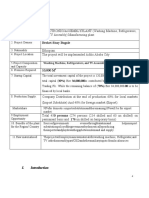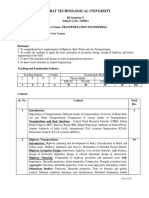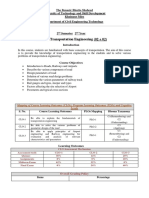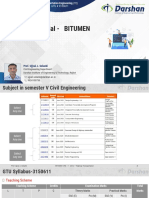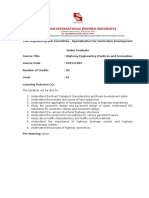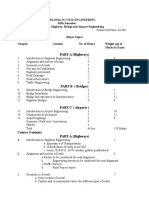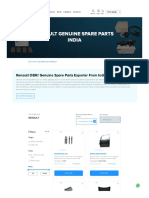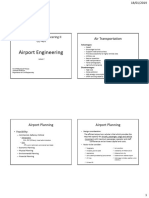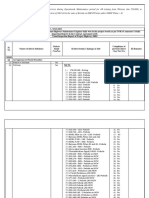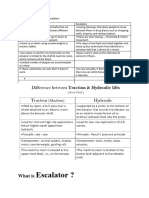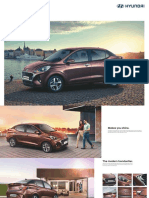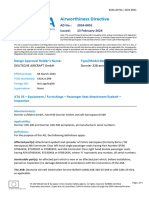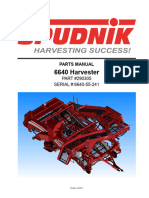RAE Syllabus (GTURanker - Com)
RAE Syllabus (GTURanker - Com)
Uploaded by
VARSHACopyright:
Available Formats
RAE Syllabus (GTURanker - Com)
RAE Syllabus (GTURanker - Com)
Uploaded by
VARSHAOriginal Title
Copyright
Available Formats
Share this document
Did you find this document useful?
Is this content inappropriate?
Copyright:
Available Formats
RAE Syllabus (GTURanker - Com)
RAE Syllabus (GTURanker - Com)
Uploaded by
VARSHACopyright:
Available Formats
GTU Material = www.GTURanker.
com
GUJARAT TECHNOLOGICAL UNIVERSITY
Bachelor of Engineering
Subject Code: 3170619
Subject Name: Railway and Airport Engineering
Semester – VII
Type of course: Professional Elective Course V
Rationale:
Railway is important mode of surface transportation. Railways are economic for the long-distance
transportation of passengers and freight on the land. India has the second largest Railway network in the
world. At present in the India, the share of goods transportation in railway is reduced than the roadways.
There is a very good scope of developing high speed trains and special corridors for freight transportation in
India. The course covers fundamental knowledge of component parts, their function, design of track and
overall operation of Railways.
Airports are important infrastructure for economic growth of any country. It requires large scale planning,
design and construction. It requires huge amount of investment. Precise engineering skill is required for the
planning, design, construction and maintenance of Airport structures. The course covers the fundamental
knowledge of various important elements of Airport Engineering. It includes the planning and design of
Airports.
Teaching and Examination Scheme:
Teaching Scheme Credits Examination Marks Total
L T P C Theory Marks Practical Marks Marks
ESE (E) PA (M) ESE (V) PA (I)
3 0 2 4 70 30 30 20 150
Content:
Sr. Total
Content
No. Hrs
1 RAILWAY ENGINEEIRNG:
Module 1:
General: Development of railways in India, Permanent way and railway track components,
8
different gauges in India, conning of wheels, Functions of various Components - Rails,
Sleepers and Ballast, Rails - types of rails, rail sections, defects in rails, creep of rails, rail
fixtures and fastenings, rail joints and welding of rails, sleepers – types, spacing and density,
Ballast – types, advantages and disadvantages, Subgrade – Requirement, embankment.
2 Module 2:
Geometric design of railway track: gradients, grade compensation, speed of trains on
5
curves, super elevation, cant deficiency, negative super elevation, curves, widening on curves.
Track layouts, Switches, Tongue Rails, Crossings, Layout of Turnout – Double Turnout,
Diamond crossing, Scissors crossing.
3 Module 3:
Railway station and Yard: 8
Railway traction and track resistance, stresses in railway track – rails, sleepers, ballast.
Points and crossings – turnouts, switches, crossings. Track junctions – types, splits,
Page 1 of 4
w.e.f. AY 2019-20
!!! For GTU Material Visit www.GTURanker.com !!!
GTU Material = www.GTURanker.com
GUJARAT TECHNOLOGICAL UNIVERSITY
Bachelor of Engineering
Subject Code: 3170619
diamond, gauntlet, scissor crossovers. Railway stations - requirements, facilities,
classifications, platforms, loops, sidings. Railway yards – types, required equipment in yards.
Signaling and control system – objectives, classification, Interlocking of signals and points.
4 AIRPORT ENGINEERING:
Module 4:
General: History, development, policy of air transport, aircrafts, aerodromes, air transport 1
authorities, air transport activities, air crafts and its characteristics, airport classifications as
per ICAO.
5 Module 5:
Airport Planning: Regional planning-concepts and advantages, location and planning of
airport as per ICAO and FAA. Airport Master plan, Airport site selection, Zoning laws, 6
Airport Elements -airfield, terminal area, zoning laws, classification of obstructions,
approach zone, turning zone, airport capacity, runway capacity, estimation of future air traffic,
development of new airport, requirements of an ideal airport layout.
6 Module :6
Run Way Design: Wind rose and orientation of runway, wind coverage and crosswind
component, factors affecting runway length, basic runway length and corrections to runway
length, runway geometrics and runway patterns (configurations), Runway marking, threshold
limits cross section of runway.
8
Taxiway Design: Controlling factors, taxiway geometric elements, layout, exit taxiway,
location and geometrics, holding apron, turnaround facility. Aprons -locations, size, gate
positions, aircraft parking configurations and parking systems, hanger-site selection, planning
and design considerations, Fuel storage area, blast pads. Wind direction indicator. LCN
system of Pavement Design, Airfield Pavement – Failures, Maintenance and Rehabilitation.
7 Module 7:
Terminal Area: Elements and requirements, terminal building functions, space requirements, 2
location planning concepts, vehicular parking area and circulation network
8 Module 8:
Grading and Drainage: Airport grading-importance, operations, airport drainage aims, 2
functions, special characteristics, basic requirements, Deign of drainage - surface and
subsurface drainage systems,
9 Module 9:
2
Air Traffic Control and Visual Aids: Need of Air traffic control, Air traffic control network,
Air traffic control aids -landing information system, airport markings and lighting.
Course Outcomes: At the end of the course, Student will be able to
Sr. Marks %
CO statement
No. weightage
CO-1 Know about railway track components, their materials, size, function and
importance 20
Page 2 of 4
w.e.f. AY 2019-20
!!! For GTU Material Visit www.GTURanker.com !!!
GTU Material = www.GTURanker.com
GUJARAT TECHNOLOGICAL UNIVERSITY
Bachelor of Engineering
Subject Code: 3170619
CO-2 Carry out geometric design of railway track 20
CO-3 Recognize about various components in diverging, merging and crossings of
20
railway tracks, stations, yards, signaling, interlocking and control systems.
CO-4 To understand the fundamentals of planning and design of Airport structures. 10
CO-5 To design of runway and taxiways for Airport 20
CO-6 To comprehend the use of Air Traffic Control and Visual Aids in the air traffic
10
operation.
Suggested Specification table with Marks (For BE only):
Distribution of Theory Marks
R Level U Level A Level N Level E Level C Level
20% 20% 20% 20% 10% 10%
Legends: R: Remembrance; U: Understanding; A: Application, N: Analyze and E: Evaluate C:
Create and above Levels (Revised Bloom’s Taxonomy)
Note: This specification table shall be treated as a general guideline for students and teachers. The actual
distribution of marks in the question paper may vary slightly from above table.
Reference Books:
1. Satish Chandra and M.M. Agrawal, “Railway Engineering”, Oxford University Press, New Delhi
2. S.C. Saxena and S. P. Arora, “A Text Book of Railway Engineering”, Dhanpat Rai & Sons, New Delhi
3. S.C. Rangwala, K.S. Rangwala and P.S. Rangwala, “Principles of Railway Engineering”, Charotar
Publishing House, Anand.
4. Dr. S. K. Khanna, M.G.Arora and S.S. Jain, “Airport Planning & Design”, Nem Chand & Bros.,
Roorkee
5. G.V. Rao, “Airport Engineering”, Tata McGraw Hill Pub. Co., New Delhi
6. S.C. Rangwala, P. S. Rangwala,“Airport Engineering”, Charotar Publishing House Pvt. Ltd, Anand
7. Robert Horonief, Francis X. McKelvey, William J. Sproule, Seth B. Young, “Planning & Design of
Airports”, Mc Graw Hill Publication.
8. Arora S. P. and Saxena (2001), “Railway Engineering”, Dhanpat Rai Publishers, New
Delhi, 2001
9. Seth Young, Alexander T. Wells, “Airport Planning & Management”, Macgraw Hill Professionals
10. Norman J. Ashford, Saleh Mumayiz, Paul H. Wright, “Airport Engineering: Planning, Design and
Development of 21st Century Airports”, John Wiley & Sons
11. Richard de Neufville, Amedeo Odoni, “ Airport System: Planning, Design and Management”,
Mc Graw Hill Education.
Page 3 of 4
w.e.f. AY 2019-20
!!! For GTU Material Visit www.GTURanker.com !!!
GTU Material = www.GTURanker.com
GUJARAT TECHNOLOGICAL UNIVERSITY
Bachelor of Engineering
Subject Code: 3170619
List of Assignments based on:
1. Component parts of Railway track, importance and their functions
2. Geometric design of railway track
3. Signal control system of Railway
4. Runway and Taxiway design of Airport
5. Terminal area, parking and drainage system at Airfield
6. Air Traffic Control and Visual Aids
Technical Visit:
1) The visit of any Railway station and yard should be carried out for understanding the components of
track and overall operation of Railway.
2) The visit of Airport site should be carried out to understand the various structures, its construction and
operations.
Page 4 of 4
w.e.f. AY 2019-20
!!! For GTU Material Visit www.GTURanker.com !!!
You might also like
- Manual Transmission 012 VWDocument177 pagesManual Transmission 012 VWnavarini100100% (1)
- Georgia Insurance Policy Information CardDocument2 pagesGeorgia Insurance Policy Information CardMoe EllingtonNo ratings yet
- ELECTRONICSASSEMBLYPLANTDocument48 pagesELECTRONICSASSEMBLYPLANTTesfaye Degefa100% (2)
- Course Orientation: Highway and Railroad EngineeringDocument6 pagesCourse Orientation: Highway and Railroad EngineeringBart Luceña100% (1)
- Gujarat Technological University: Subject Name: Semester - VIIDocument4 pagesGujarat Technological University: Subject Name: Semester - VIIKSghNo ratings yet
- Gujarat Technological University: W.E.F. AY 2018-19Document4 pagesGujarat Technological University: W.E.F. AY 2018-19Rushil ShahNo ratings yet
- Gujarat Technological University: Page 1 of 5Document5 pagesGujarat Technological University: Page 1 of 5Axay ShahNo ratings yet
- Transportation-II SyllabusDocument3 pagesTransportation-II SyllabusAshok Kumar RajanavarNo ratings yet
- Rbte PDFDocument3 pagesRbte PDFAsha JoshiNo ratings yet
- CE07306 Transportation EnggDocument4 pagesCE07306 Transportation EnggbijubijayNo ratings yet
- Railway, Airport & Harbour Engineering-TY BTech-Part-IIDocument3 pagesRailway, Airport & Harbour Engineering-TY BTech-Part-IIAshok Kumar RajanavarNo ratings yet
- CE308 Transportation Engineering - I PDFDocument2 pagesCE308 Transportation Engineering - I PDFangel graceNo ratings yet
- CE407 Transportation Engineering - IIDocument2 pagesCE407 Transportation Engineering - IIKim ShaeyunNo ratings yet
- Chapter 1Document63 pagesChapter 1tpc civilNo ratings yet
- M.Tech - Transport Engg. II Year SyllabusDocument14 pagesM.Tech - Transport Engg. II Year SyllabusSivaNo ratings yet
- Rajalakshmi Engineering College Lesson PlanDocument4 pagesRajalakshmi Engineering College Lesson PlanjvinothupendraNo ratings yet
- Gujarat Technological UniversityDocument3 pagesGujarat Technological UniversityDeepak OraonNo ratings yet
- Ce2303 RailwaysDocument1 pageCe2303 Railwaysshara000No ratings yet
- Gujarat Technological University: Page 1 of 4Document4 pagesGujarat Technological University: Page 1 of 4Dipika GuptaNo ratings yet
- BCV403 - Transportation EngineeringDocument3 pagesBCV403 - Transportation EngineeringAnupEkboteNo ratings yet
- Gujarat Technological University: Pavement Design and Highway ConstructionDocument4 pagesGujarat Technological University: Pavement Design and Highway ConstructionAxay ShahNo ratings yet
- Course Outline Transportation EngineeringDocument3 pagesCourse Outline Transportation EngineeringKhalil AhmedNo ratings yet
- Course Title: Transportation Engineering Course Code: 6014 Course Category: A Periods/Week: 6 Periods/Semester: 90 Credits: 5Document5 pagesCourse Title: Transportation Engineering Course Code: 6014 Course Category: A Periods/Week: 6 Periods/Semester: 90 Credits: 5Asharahul RahulNo ratings yet
- Transportation Engineering Polytechnic Textbooks PDFDocument226 pagesTransportation Engineering Polytechnic Textbooks PDFBabu HrNo ratings yet
- Gujarat Technological University: Highway Engineering B.E. 5 SemesterDocument3 pagesGujarat Technological University: Highway Engineering B.E. 5 SemesterAsha JoshiNo ratings yet
- Airport Seaport HarbourDocument8 pagesAirport Seaport HarbourSAKHI U 20MLCE110% (1)
- RCE076 Railways, Airports & Water WaysDocument2 pagesRCE076 Railways, Airports & Water WaysShubham Kesarwani50% (2)
- Transportation EngineeringDocument8 pagesTransportation EngineeringAsharahul RahulNo ratings yet
- With Effect From The Academic Year 2012-2013Document2 pagesWith Effect From The Academic Year 2012-2013Min Chan MoonNo ratings yet
- Chapter 4Document56 pagesChapter 4tpc civilNo ratings yet
- Railway, Bridge and Tunnel EngineeringDocument3 pagesRailway, Bridge and Tunnel EngineeringDivyesh ThakareNo ratings yet
- University of Engineering and Technology Lahore: Department: Civil Engineering Section Course Outline ReportDocument2 pagesUniversity of Engineering and Technology Lahore: Department: Civil Engineering Section Course Outline ReportEngr.Hamid Ismail CheemaNo ratings yet
- Transportation Engineering ManagementDocument12 pagesTransportation Engineering ManagementvenugopagNo ratings yet
- Transportation Engineering-IIDocument3 pagesTransportation Engineering-IIravi kumarNo ratings yet
- CEF425-Airport, Railways and Waterways Handout Second Semester 2015-16 Final For CMS UploadDocument4 pagesCEF425-Airport, Railways and Waterways Handout Second Semester 2015-16 Final For CMS UploadVinayaka RamNo ratings yet
- Infrastructure EngineeringDocument3 pagesInfrastructure EngineeringGovind Shriram ChhawsariaNo ratings yet
- Nirama Uni. - CL504 Transportation Engineering I - 16062015 - 023216PMDocument1 pageNirama Uni. - CL504 Transportation Engineering I - 16062015 - 023216PMsujjvalNo ratings yet
- Railway and Tunnel EngineeringDocument8 pagesRailway and Tunnel EngineeringSAKHI U 20MLCE11No ratings yet
- MTech CIVIL 2013 PDFDocument45 pagesMTech CIVIL 2013 PDFPrasannaVenkatesanNo ratings yet
- Ce208 Highway and Railway EngineeringDocument2 pagesCe208 Highway and Railway EngineeringVENKATANARAYANANNo ratings yet
- Unit I Railways Classification Lines Track Traction Tractive Resistance by R Bhagat 2020Document61 pagesUnit I Railways Classification Lines Track Traction Tractive Resistance by R Bhagat 2020shah_faizan123No ratings yet
- 6th Sem CE SyllabusDocument10 pages6th Sem CE SyllabusAmenul HoqueNo ratings yet
- Radha RAILWAYS SyllabusDocument1 pageRadha RAILWAYS SyllabusgurunathsudheerNo ratings yet
- Gujarat Technological University Civil (Transportation Engineering)Document3 pagesGujarat Technological University Civil (Transportation Engineering)dilipkalita2021No ratings yet
- Course DetailsDocument9 pagesCourse DetailsDinesh KumarNo ratings yet
- Gujarat Technological University: W.E.F. AY 2018-19Document3 pagesGujarat Technological University: W.E.F. AY 2018-19KSghNo ratings yet
- Chapter 6Document92 pagesChapter 6tpc civilNo ratings yet
- Highway Engg NotesDocument233 pagesHighway Engg NotesPrathik Arjun100% (1)
- 7th Semester Syllabus CEDocument7 pages7th Semester Syllabus CEgayatribhandari69No ratings yet
- Highway EngineeringDocument2 pagesHighway EngineeringKesava ksNo ratings yet
- 502 Highway EngineeringDocument5 pages502 Highway EngineeringKARAN TRIVEDINo ratings yet
- HRE act 1Document3 pagesHRE act 1Esguerra John markNo ratings yet
- 4 TH Semester SyllabusDocument11 pages4 TH Semester Syllabusrk2003kishoreNo ratings yet
- Chapter 3Document66 pagesChapter 3tpc civilNo ratings yet
- Highway EngineeringDocument3 pagesHighway EngineeringChitvan Bansal100% (1)
- Infra Teaching PlanDocument4 pagesInfra Teaching PlanPiyush BhandariNo ratings yet
- Higway, Bridge&AirportDocument7 pagesHigway, Bridge&AirportShaik Jhoir50% (2)
- Neues verkehrswissenschaftliches Journal - Ausgabe 26: User-based Adaptable High Performance Simulation Modelling and Design for Railway Planning and OperationsFrom EverandNeues verkehrswissenschaftliches Journal - Ausgabe 26: User-based Adaptable High Performance Simulation Modelling and Design for Railway Planning and OperationsNo ratings yet
- Motor Truck Logging Methods Engineering Experiment Station Series, Bulletin No. 12From EverandMotor Truck Logging Methods Engineering Experiment Station Series, Bulletin No. 12No ratings yet
- Making Your N Gauge Railway More Realistic: In the BR Blue and Sectorisation ErasFrom EverandMaking Your N Gauge Railway More Realistic: In the BR Blue and Sectorisation ErasNo ratings yet
- Telecommunications Traffic : Technical and Business ConsiderationsFrom EverandTelecommunications Traffic : Technical and Business ConsiderationsNo ratings yet
- Complete Streets Design Guideline Manual 1Document86 pagesComplete Streets Design Guideline Manual 1Tariq ToffaNo ratings yet
- Renault Parts Exporter From IndiaDocument3 pagesRenault Parts Exporter From IndiaSmart Parts ExporterNo ratings yet
- Mobile Car Detailing in Detroit - Car WashDocument3 pagesMobile Car Detailing in Detroit - Car WashDetailXPerts DetroitNo ratings yet
- Contract of CarriageDocument62 pagesContract of CarriageHeidy SantanaNo ratings yet
- Transportation Engineering II (Lec - 7)Document15 pagesTransportation Engineering II (Lec - 7)alqazi.designerNo ratings yet
- 2.the Cargo Stowage and Securing CodeDocument6 pages2.the Cargo Stowage and Securing CodeShubham Saurav100% (1)
- SOAL Latihan Praktik UKKDocument12 pagesSOAL Latihan Praktik UKKAlbert RobertusNo ratings yet
- Goodyear DatasheetDocument8 pagesGoodyear DatasheetasfadsfNo ratings yet
- Global EV Outlook 2020Document276 pagesGlobal EV Outlook 2020Tri Ho100% (1)
- Dir 05.10.2023Document28 pagesDir 05.10.2023MSV Tech ChalakudyNo ratings yet
- Illustrated Parts List 28T700: Model SeriesDocument10 pagesIllustrated Parts List 28T700: Model SeriesAndyNo ratings yet
- 1-350 HMS Illustrious Superstructure For Airfix KitDocument12 pages1-350 HMS Illustrious Superstructure For Airfix KitDoru SicoeNo ratings yet
- Difference Between LiftsDocument5 pagesDifference Between LiftsAsha GururajNo ratings yet
- Vehicle Specifications - LADA Granta Sedan - LADADocument1 pageVehicle Specifications - LADA Granta Sedan - LADAcfcr3272No ratings yet
- English Class 3 Question BankDocument66 pagesEnglish Class 3 Question Bankjaigovind boobNo ratings yet
- Mirai EbrochureDocument19 pagesMirai Ebrochureoguzhan.akselNo ratings yet
- Munazir SiddiquiDocument2 pagesMunazir SiddiquiMD AKHLAQUER RAHMANNo ratings yet
- Query Result 2023-10-12T16 19 41.042062+07 00Document102 pagesQuery Result 2023-10-12T16 19 41.042062+07 00monanglgaolNo ratings yet
- AuraDocument10 pagesAuraKarthick NatrajanNo ratings yet
- The Development of The New Ford Heavy Duty Truck Engine, ECOTORQDocument11 pagesThe Development of The New Ford Heavy Duty Truck Engine, ECOTORQErick RodriguesNo ratings yet
- Maintenance Error Decision Aid (MEDA) Results Form: Section I - General InformationDocument6 pagesMaintenance Error Decision Aid (MEDA) Results Form: Section I - General InformationedgarNo ratings yet
- Addressing Urban Sprawl Redefining Bacoor West Through New Urbanism and Blue-Green City ApproachDocument41 pagesAddressing Urban Sprawl Redefining Bacoor West Through New Urbanism and Blue-Green City ApproachTristan de LunaNo ratings yet
- CBLM Brake SystemDocument15 pagesCBLM Brake Systemace ebradoNo ratings yet
- Almacén Ubicación Código Descripción UM Stock Conteo 1 Dife Conteo 2 Venta Diferido Dife 2 Guia Tránsito Inventario FinalDocument8 pagesAlmacén Ubicación Código Descripción UM Stock Conteo 1 Dife Conteo 2 Venta Diferido Dife 2 Guia Tránsito Inventario FinalCris Cris StoneNo ratings yet
- Easa Ad 2024-0051 1Document3 pagesEasa Ad 2024-0051 1buracurexboNo ratings yet
- 66arrancadeira Spudnik 6640 HarvesterDocument217 pages66arrancadeira Spudnik 6640 Harvesterhelijunior67151No ratings yet
- raw:/storage/emulated/0/Download/ANAR SEYIDOV CV1Document6 pagesraw:/storage/emulated/0/Download/ANAR SEYIDOV CV1Anar SeidliNo ratings yet


